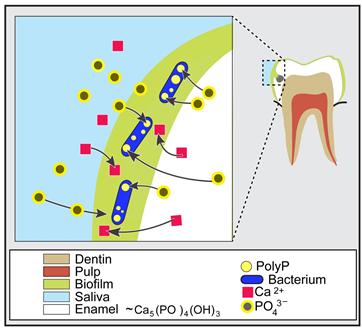U-M researchers document new process that may exacerbate tooth decay

In a new study published in Applied and Environmental Microbiology, an interdisciplinary team of University of Minnesota researchers found some bacteria that absorb and accumulate phosphate from saliva may play a role in tooth decay.
The study suggests dental plaque contributes to dental decay by removing phosphate from the mouth and altering the chemistry of saliva. This is significant because previous research focused solely on the role of bacteria in tooth decay through the production of acids from sugars.
Knowing that low concentrations of soluble mineral ions, such as phosphate, in the mouth can accelerate dental decay, researchers from the School of Dentistry’s Division of Pediatric Dentistry and from the Department of Earth Sciences in the College of Science and Engineering asked if oral bacteria themselves can substantially change mineral ions in their local surroundings.
It’s a question that was sparked by recent research in marine environments that shows bacteria can cause calcium phosphate minerals, similar to the makeup of the mineral portion of our teeth, to form or dissolve through the absorption or the release of phosphorus from inside their cells. These bacteria store the phosphorus as a long-chain polymer known as polyphosphate.
In this new study, University of Minnesota researchers show that dental plaque contains abundant bacteria that absorb phosphate from their surroundings and store it inside the cell as polyphosphate, a process that may exacerbate tooth decay.
"Making this breakthrough required bringing together ideas and approaches from diverse scientific disciplines, from oceanography to dentistry," said Jake Bailey, associate professor with the Department of Earth Sciences.
Researchers believe it could help shape the development of future oral hygiene products or treatment approaches to reduce tooth decay.
“Future work will need to be conducted to understand the factors that control when and why these bacteria take up phosphate and how their presence impacts overall oral health,” said Robert Jones, associate professor with the Division of Pediatric Dentistry.
“I am hopeful that our collaboration could lead to new and alternative approaches to combating and managing oral disease,” said Ashley Breiland, lead author and researcher with the Department of Earth Sciences.
Funding was provided by the University of Minnesota Office of the Vice President for Research through the Minnesota Futures grant.